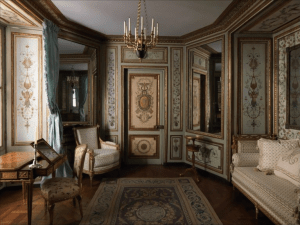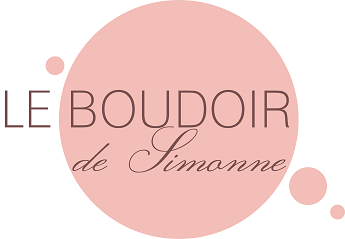Boudoir – the mysterious women's room
You may be wondering why I chose boudoir as the brand name for my jewelry. For me, this word immediately creates a feeling of femininity, mystery, and of course something French. And since everything French is near and dear to me, very quickly and naturally this little word turned into LE BOUDOIR de Simonne… But here's a bit of history to clear up any misunderstandings, and for a bit of general culture.

The boudoir of the Hotel Creon, transported and installed in the Metropolitan Museum of Art in New York
Often the word "boudoir" leads to associations with love games. We owe this to the Marquis de Sade, known for his libertine views and his works, sounding like a true apology for sexual pleasures. By the way, one of his works is called "Philosophy in the boudoir" and tells about the erotic "training" of a 15-year-old girl by a tricked lady who introduces her to the love games and the innermost secrets of Venus. But what exactly is a boudoir?
A boudoir is a small, elegant parlor, usually situated between the dining-room and the bedroom, specially designed for the use of the ladies, and into which they retire when they wish to be alone or to talk with their girlfriends or confidants, and perhaps with lovers.
Architecture, manners and so on
The appearance of the boudoir in French mansions in the 18th century corresponded to a change in customs related to the development of relations between men and women, and had an impact on interior design and the organization of the various spaces in the home. While for bourgeois men public expression in salons became a way of affirmation, women spent some of their time in more intimate spaces. In fact, the salon becomes a place more for men's gatherings. And for the boudoir, we can only guess how this secret and exclusive female space fired the male imagination.

Queen Marie-Antoinette's Oriental boudoir at the Palace of Fontainebleau.
This period was also characterized by a profound change in the way the living space was organized, and therefore it is not surprising that the boudoir appeared precisely then, of course first in aristocratic mansions and apartments. The former "universal" rooms, the furniture of which varied widely (instead of a dining table for serving, trestles were brought there, and were taken away immediately after the meal was finished and served both as a place for receiving guests and for sleeping) began to have its specifics. The "room", still little defined at the end of the seventeenth century, began to be defined according to the function assigned to it, and thus appeared the dining room, the bathroom, and even the drawing room for receptions and guests. The boudoir, while fitting perfectly into this movement of differentiation of spaces, is an exception, as it doesn't really have a specific function other than to allow its owner to retreat and use it as he pleases.
Before I finally choose the name LE BOUDOIR de Simonne I read various articles and texts on the subject. Trying to find out more about this legendary space, I quickly realized that most people's idea of the boudoir is a fantasy that does not quite match the reality of the 18th century and is mostly due to the literary descriptions of this place. For the first time, boudoir is found in a poem from 1726, while it did not enter dictionaries and encyclopedias until the 1940s. But why do we think of it as a female or even a courtesan's space when the descriptions make it very clear that in the mansions and apartments of the time it was a room belonging to both men and women? Why this image of a sexual space, when in historical texts we find very few boudoirs with really this use? First is the influence of literature, and "Philosophy in the Boudoir" is only the tip of the iceberg. Literary texts that tell about intimate experiences in the boudoir or simply about the boudoir itself are countless. Most of them date from the second half of the century, and we observe that this room can have multiple uses: it can even be a political spy office!

Architectural plan of the ground floor of the Episcopal Palace in Rennes - the boudoir is in the right wing, with a direct connection to the study and a view, a door and its own stairs to the garden.
Proof that the boudoir was not only a space for intimate experiences was found in the plan of the bishop's palace in Rennes, approved by the king himself in 1764. It is a small room with a fireplace and a view of the garden – features that are fairly representative of most boudoirs of the time. The architectural plans of Louis XV's apparatus also provided for a boudoir.
Surprisingly, at the end of the century, the boudoir appeared in more modest residences - in apartments with only four or five rooms. In these cases, there were three main rooms, which we could call utility rooms - bedroom, bathroom and dining room - and two rooms used for receiving guests and for seclusion, which were respectively the living room and the boudoir. It is in these residences that the function of this room is ultimately clearest, because its opposition to the company salon shows that it is intended to serve more as a place of rest than as a place of reception, which can sometimes happen in more - the majority of aristocratic hotels.
The real turning point in the history of the boudoir actually occurred at the beginning of the 19th century. At this point, the boudoir becomes the embodiment of men's fantasies, which the authentic boudoir does not correspond to. Completely imbued with the feeling of femininity, the boudoir, which previously represented a form of freedom in the home, is no longer perceived as the room of the respectable woman who is wife and mother, but becomes the lair of the courtesan. This idea was marginal in the 18th century, but continued to develop in literature and eventually prevailed as a description of the boudoir throughout the centuries.
And what did the boudoir look like in the 18th century?
The location of the boudoir was relatively isolated, close to the bedroom, bathroom and dressing room. Almost every boudoir had a fireplace, creating a warm, cozy atmosphere, and the windows opened onto the garden with a pleasant view. The boudoir was a very private space, arranged entirely according to the tastes and whims of the occupant. A diverse library, an elegant desk, a soft sofa and precious objects completed the atmosphere. After all, this space was a very modern room: a space without function that exists and can only be defined according to the desires of the occupant. This is unheard of in housing history!
Je boude, tu boudes, elle boude….Where does the word boudoir come from?
It is assumed that the word comes from the verb bouder, which we can translate as "to sulk". However, it would be reductive to stick only to this explanation: in the 18th century, this word was already charged with an infantilizing connotation. It is unlikely to define a part of the habitable space according to this term alone. It can, however, come close to the word "boude" from the French of the time, meaning "belly", and this simile would make the boudoir a warm cocoon where one would retreat to immerse oneself without necessarily being in bad mood. In addition, "boudoir" is also similar to the English word "bower", which rightly means a private study from the 18th century. Since the appearance of the word in French occurs during a period of relative Anglophilia, it is possible that its origin is Anglo-Saxon. In any case, it is unlikely that the contemporaries of the boudoir thought that it was used only for "pouting". The boudoir is above all a kind of study, with all the uses that this implies, from choosing an outfit to a pleasant daytime rest.
And have you eaten boudoir??
 Well, I have never seen cakes decorated like boudoirs, but I really like to eat boudoirs, especially with coffee. You've had boudoir too, especially if you love tiramisu! But what are we talking about?
Well, I have never seen cakes decorated like boudoirs, but I really like to eat boudoirs, especially with coffee. You've had boudoir too, especially if you love tiramisu! But what are we talking about?
Boudoir is a dry and crispy cookie with an oblong shape and sprinkled with powdered sugar. It is traditionally used as an accompaniment to wine or champagne, as well as the preparation of the Charlotte cake and tiramisu desserts. It is said that the crispy biscuit was an invention of one of the greatest chefs, Marie-Antoine Karem - the first chef in the history of gastronomy, who was named chef, the inventor of the chef's hat. Karem created the biscuit especially for Talleyrand, and it owes its name to the "boudoir diplomacy" (or boudoir diplomacy?) for which the politician was known.
If you made it to the end, you found it interesting! Therefore, I will tell you different stories from the boudoirs of famous and less famous ladies from the history of the blog.


